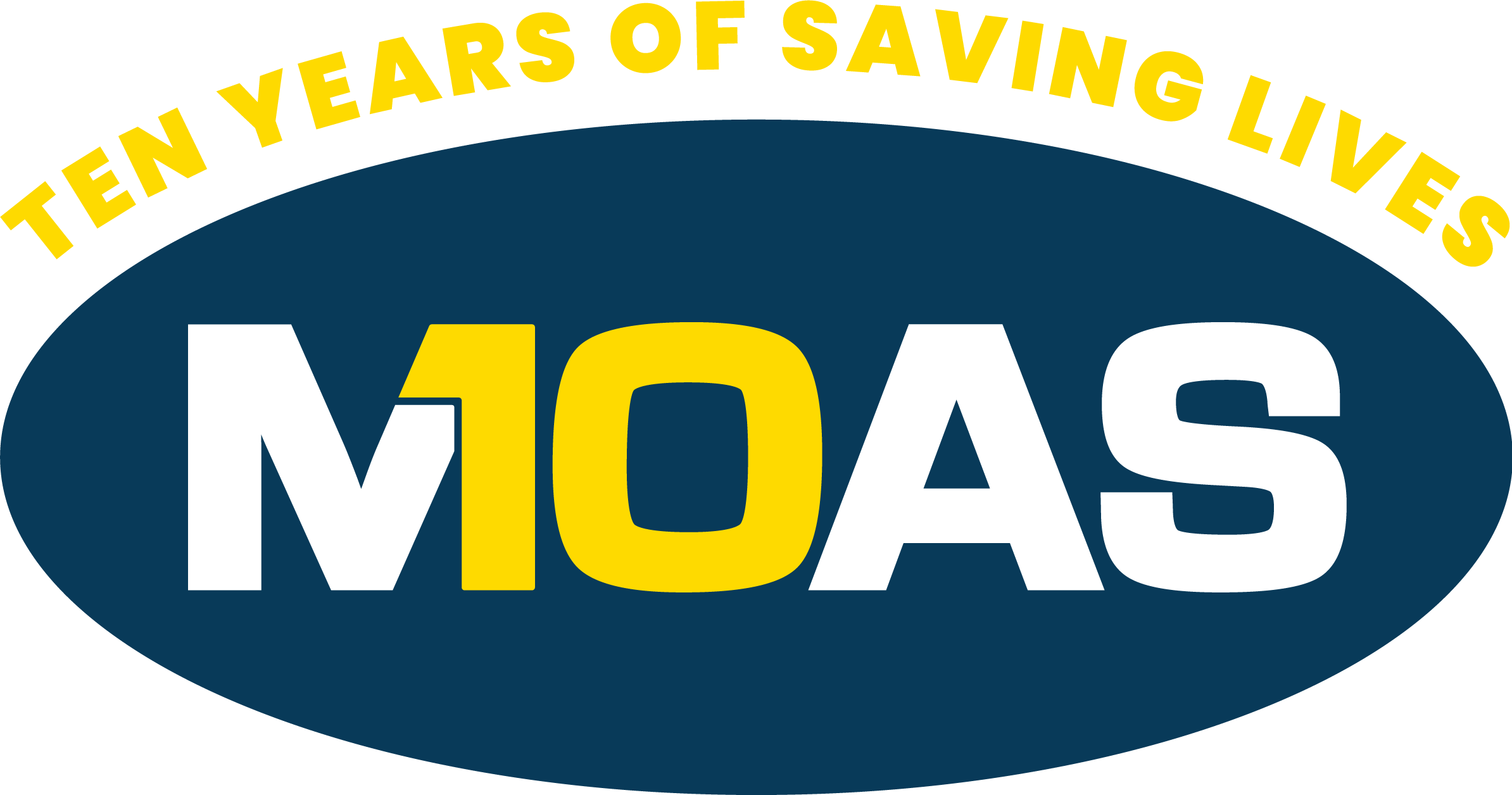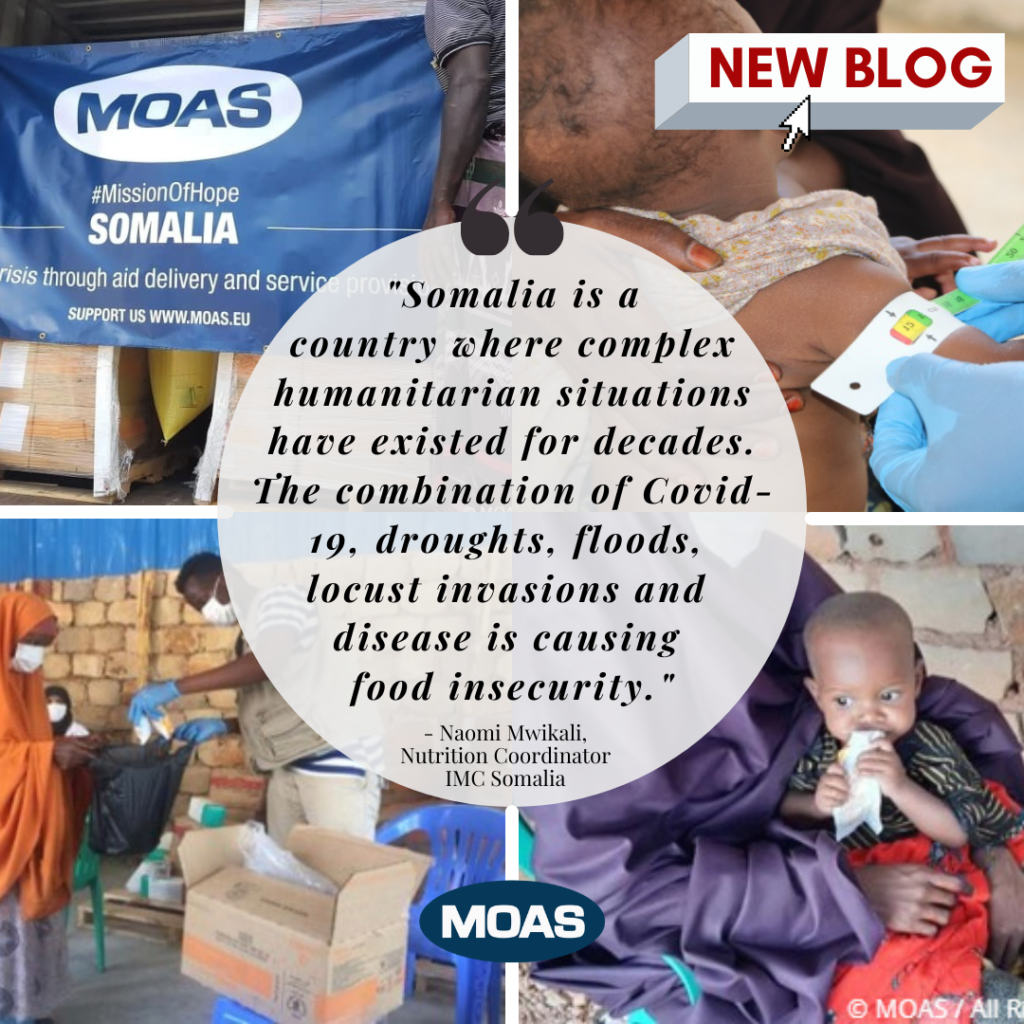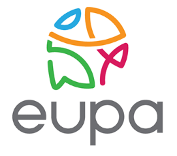Food insecurity and hunger remain a significant issue in too many parts of the world, and it is a major concern for us at MOAS. We do our best to bring relief to communities and countries affected by this threat, which has been exacerbated by the COVID-19 pandemic. This is why we deliver food shipments to countries such as Yemen and Somalia, where humanitarian crises have led to extremely high levels of food insecurity and malnutrition.
In Somalia, where we sent our very first shipment last year, our in-country partners International Medical Corps are overseeing distribution of the ready-to-use supplementary food Plumpy’Sup™ donated by our supply partner Edesia. It is provided to children, women and men affected by Moderate Acute Malnutrition.
This week we spoke to Naomi Mwikali, Nutrition Coordinator of International Medical Corps’ Somalia mission, to gain better insight into their work and the challenges they face in Somalia, a country affected by multiple threats.
- What are the main causes of food insecurity in Somalia?
Naomi Mwikali: “Somalia is a country where complex humanitarian situations have existed for decades, but the leading cause of food insecurity at present is rising food prices due to a combination of COVID-19, droughts, floods, locust invasions and disease.
Unfortunately, after decades of crisis here in Somalia, we are seeing a decline in humanitarian support due to “donor fatigue.”
There are particular challenges relating to women and children. For example, in Somalia, just 21% of children below six months are exclusively breastfed, and only 11% of children are able to access a minimally acceptable diet. Accessing clean water is another concern.
For mothers, the stresses of forced displacement, family and other tensions can contribute to mental health problems. This can exacerbate food insecurity in the home because if the primary caretaker is not able to provide food, there will be a general reduction in food intake for the whole family.”
- How do climate change and political instability affect food production and distribution?
NM: “Since 1990, Somalia has experienced more than 30 serious climate-change-related events, including droughts and floods, and the frequency of these events is increasing. More than 80% of the country is already affected by drought this year, while increased rainfall has caused flooding in other areas.
For example, in areas like the Mudug region, droughts and lack of water drive people into IDP camps. But, on the other side of the country, in Middle Shebelle, we have a river that has burst its banks and people are impacted by floods. Therefore, Somalia is currently dealing with two distinct climatic effects at the same time.
Flooding can leave people cut off from food and essential services, and medical staff may have to use boats to reach villages. Droughts force people to move away from areas where we have established clinics, and so we must follow them. All this drives up programming costs.
The price of water also skyrockets because during floods, water easily becomes extremely contaminated, and during droughts, the lack of water forces people to travel long distances to search for clean water. In addition, water shortages lead to poor hygiene practices, which leads to more disease. So, the problems created by climate change all become connected.”
- What has the COVID-19 pandemic meant for Somalia?
NM: “The main organizations in Somalia already work with very limited funding, so sometimes we are forced to prioritize care for the most vulnerable in the communities; adding COVID-19 to this mix further strains the already overburdened health system.
The COVID-19 restrictions disrupted transport services, limiting the distribution of supplies, including foodstuff, medicines and essential nutrition commodities. That leads to increased food prices, which compromises household food security—particularly if income has also been reduced.
The pandemic has also affected Somalia because other countries have been hoarding lifesaving supplies for themselves, so that means we have very little or nothing coming in from outside, especially during the initial stages of the COVID-19 pandemic.
Another significant challenge is that a third of people in Somalia live in overcrowded IDP camps. That creates practical difficulties for people trying to follow COVID-19 containment measures.
- What are the main impacts of food insecurity on the people of Somalia?
NM: “Food insecurity causes people to migrate. Migration can exacerbate the risk of gender-based violence (GBV), including vulnerability to sexual violence due to, for example, lack of secure shelters. Mothers may be too busy looking for the next meal to focus on breastfeeding or caring for their children, which is a major cause of malnutrition. Households may also fall into negative coping mechanisms, like reducing the number of meals a day, or feeding only the children, but still not properly, as they don’t have adequate, nutritious food.”
- What are International Medical Corps’ activities in Somalia?
NM: “In a complex humanitarian context like Somalia, you need an intersectoral or multisectoral approach. For instance, International Medical Corps’ interventions in the health sector involve running health facilities and managing staff, purchasing and supplying drugs, and generally supporting the Ministry of Health in providing primary and secondary health care services.
The supplies that MOAS provides are used in our nutrition sector screening, where our community health workers visit households to assess children and establish their nutritional status. If they are malnourished, they get admitted for treatment at our health facilities. In addition, we have in-patient and outpatient management for acute malnutrition, which is where the supplies that MOAS provides us come in handy. It is in these centers where severely or moderately acutely malnourished patients get treated.
We also conduct growth monitoring, which includes taking weight and height measurements, providing vitamin A supplementation, deworming, vaccination and child development check-ups.
As part of our program, we provide maternal, infant and young child nutrition services mainly for mothers and children under five years old. We also assist expectant mothers throughout their pregnancy by offering counselling on proper diet, prenatal health care, the importance of taking iron folate supplements and encouraging them to deliver their babies at health facilities. Moreover, we operate a post-natal clinic to support breastfeeding and feeding babies with special needs, including illness and HIV.
International Medical Corps initiated the formation of mother-to-mother support groups in several villages, where pregnant and lactating mothers discuss breastfeeding and complementary feeding issues. In addition, community health workers support them in conducting cooking demonstrations and developing recipes by utilizing the different foods locally available in the market to make balanced meals for their families. Similarly, we coordinate general health and nutrition education promotions, such as positive health-seeking behaviours, food and environmental hygiene practices. In an effort to boost household income and enhance food security and nutrition for families, we equip mothers with kitchen gardening skills like growing vegetables and rearing small domestic animals, like chickens.
Our water, sanitation and hygiene (WASH) interventions involve teaching communities about hygiene practices, distributing hygiene kits, constructing latrines and promoting their use. In addition, the WASH team also rehabilitates boreholes and shallow wells for easy access to clean water. In the IDP camps, where we cannot drill boreholes, we provide water trucking services.
Within all these programs, we also operate protection programs to deal with gender-based violence issues for women and provide proper assistance for them.”
- What do deliveries of food and therapy foods, such as those provided by MOAS and International Medical Corps, mean for communities in crisis today?
NM: Funding is always an issue, and funding gaps mean that we cannot always meet the needs of the communities we serve. The donation of supplies means a lot—Edesia and MOAS donations help us support children when they are moderately malnourished, meaning fewer children will go on to suffer from severe malnutrition, and even fewer will die.
Transportation costs are very high in Somalia as we are forced to use air transport because of security issues. Therefore, when MOAS sends us supplies, it ensures we can respond to many emergencies without the added burden of transportation costs. It is for this reason that MOAS’ assistance is truly essential in our work.”
Final thoughts
We are so grateful to Naomi and International Medical Corps for this amazing testimonial and her insights on Somalia’s situation and their tireless work. Her testimonial shows how food insecurity and hunger are strongly linked to many other factors such as climate change or mental health and how a multisectoral approach is essential to tackle these challenges. The shipments of food aid that MOAS sends to Somalia are lifesaving for children, and thanks to our partnership with International Medical Corps, we recognize our contribution in enhancing the availability of vital, lifesaving services to vulnerable communities.
*This interview has been edited for clarity and length.
If you are interested in the work of MOAS and our partners, please follow us on social media, sign up to our newsletter and share our content. You can also reach out to us any time via [email protected]. If you want to support our operations, please give what you can at www.moas.eu/donate.


